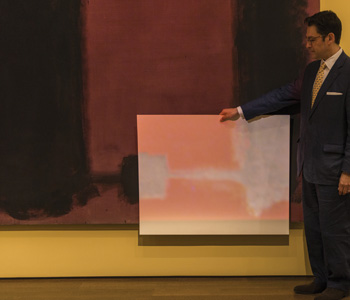Feature
Light Repairs Art: Optical Overlays Restore Faded Masterworks
Light or oxidation degrades dyes and pigments, altering artworks over the years and centuries. With some new techniques, art conservators can use light to restore the faded glory of a masterpiece without changing the original.
 Narayan Khandekar, senior conservation scientist, Straus Center for Conservation and Technical Studies, Harvard Art Museums, holding up a white card which shows the digital projection on Mark Rothko’s Panel Four in the exhibition Mark Rothko’s Harvard Murals, on display at the Harvard Art Museums through 26 July, 2015. [© 2014 Kate Rothko Prizel and Christopher Rothko / Artists Rights Society (ARS), New York. Photo: Peter Vanderwarker, © President and Fellows of Harvard College.]
Narayan Khandekar, senior conservation scientist, Straus Center for Conservation and Technical Studies, Harvard Art Museums, holding up a white card which shows the digital projection on Mark Rothko’s Panel Four in the exhibition Mark Rothko’s Harvard Murals, on display at the Harvard Art Museums through 26 July, 2015. [© 2014 Kate Rothko Prizel and Christopher Rothko / Artists Rights Society (ARS), New York. Photo: Peter Vanderwarker, © President and Fellows of Harvard College.]
Art conservation requires striking a delicate balance between preserving the original work and making it look as it did when new. The current consensus is that conservators should make only reversible changes: Instead of dabbing new paint directly on a damaged or discolored area, for example, they first coat the area with a transparent varnish that solvents can easily remove without damaging the original, then apply new paint on the coating.
…Log in or become a member to view the full text of this article.
This article may be available for purchase via the search at Optica Publishing Group.
Optica Members get the full text of Optics & Photonics News, plus a variety of other member benefits.
